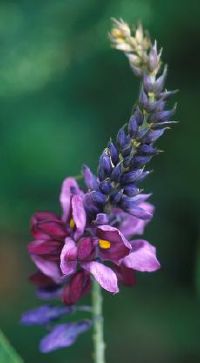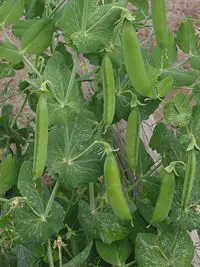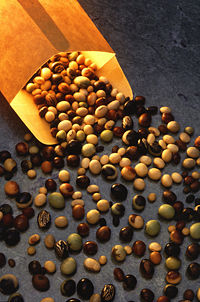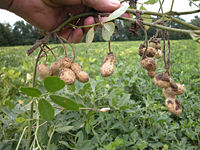Difference between revisions of "Legume" - New World Encyclopedia
| Line 28: | Line 28: | ||
The term is derived from the [[French language|French]] word "légume" (which, however, has a wider meaning and refers to any kind of [[vegetable]]). The French word comes from the Latin ''legumen'', which means "anything that can be gathered." | The term is derived from the [[French language|French]] word "légume" (which, however, has a wider meaning and refers to any kind of [[vegetable]]). The French word comes from the Latin ''legumen'', which means "anything that can be gathered." | ||
| + | |||
| + | ==The Sub-Families== | ||
| + | The legumous plants are traditionally classified into three subfamilies, sometimes raised to the rank of family in the order Fabales, on the basis of [[flower]] morphology (specifically, [[petal]] shape): | ||
| + | |||
| + | *''Caesalpinioideae'': The flowers are [[zygomorphic]], but are very variable, e.g. closely resembling Faboideae flowers in ''[[Cercis]]'', while symmetrical with five equal petals in ''[[Bauhinia]]''. | ||
| + | *''Mimosoideae'': The petals are small, and are frequently globose or spicate and the stamens are the most showy part of the flower. | ||
| + | *''Faboideae'' or ''Papilionoideae'' (Fabaceae ''sensu strictu'' or Papilionaceae): One petal is large and has a crease in it, the two adjacent petals are on the sides, and the two bottom petals are joined together at the bottom, forming a boat-like structure. | ||
| + | |||
==Nitrogen fixation== | ==Nitrogen fixation== | ||
| Line 37: | Line 45: | ||
==Legumes in nature== | ==Legumes in nature== | ||
| + | Legumes grow world-wide in many different environments. Some are annual herbs, some are vines, and some are bushes and trees. They play important roles in natural ecosystems because their nitrogen fixation enriches the soil. They also provide food for many animals. Many have beautiful flowers, such as lupine and albizia. | ||
| + | |||
===Acacia=== | ===Acacia=== | ||
Acacia trees, genus ''Acacia'', are also legumes. There are about 1300 species which grow world-wide, mostly in dry tropical to warm-temperate regions. | Acacia trees, genus ''Acacia'', are also legumes. There are about 1300 species which grow world-wide, mostly in dry tropical to warm-temperate regions. | ||
| + | |||
===Kudzu=== | ===Kudzu=== | ||
[[Image:Rainforest 1221.jpg|thumb|250px|Kudzu overtaking trees]] | [[Image:Rainforest 1221.jpg|thumb|250px|Kudzu overtaking trees]] | ||
| − | Kudzu, ''Pueraria lobata'', is another well-known legume. It is native to eastern Asia and was introduced from [[Japan]] to the [[United States]] as livestock fodder and as a | + | Kudzu, ''Pueraria lobata'', is another well-known legume. It is native to eastern Asia and was introduced from [[Japan]] to the [[United States]] as livestock fodder and as a ground cover to control erosion. Because of its rapid growth and great size, it can grow as much as 30 cm (12 inches) a day in the right conditions, it has become an harmful invasive species in much of the Southeast. It replaces native vegetation, even killing trees by covering them and cutting off their access to sunlight. |
==Cultivation== | ==Cultivation== | ||
[[Image:Soybeanvarieties.jpg|thumb|200px|right|Varieties of soybean seeds]] | [[Image:Soybeanvarieties.jpg|thumb|200px|right|Varieties of soybean seeds]] | ||
| + | Legumes were among the first plants cultivated by humans. One reason is the the large seeds of most species are easy to gather and store and provide good nutritional value. | ||
| + | |||
| + | The first legumes cultivated in the Middle East, perhaps as much as 10,000 years ago, were | ||
| + | the lentil ''Lens culinaris'', the [[pea]] ''Pisum sativum'', the chick pea ''Cicer arietinum'', the bitter vetch ''Vicia ervilia'', and the broad bean ''Vicia faba''. | ||
| + | |||
| + | The soybean, ''Glycine max'' was first cultivated in [[China]], perhaps 5,000 years ago. It is now the most world's most important legume crop. | ||
| + | |||
Farmed legumes fall into two classes: [[forage]] and [[cereal|grain]]. | Farmed legumes fall into two classes: [[forage]] and [[cereal|grain]]. | ||
* Forage legumes, like [[alfalfa]], [[clover]] and [[vetch]], are sown in [[pasture]] and grazed by livestock. | * Forage legumes, like [[alfalfa]], [[clover]] and [[vetch]], are sown in [[pasture]] and grazed by livestock. | ||
| − | * Grain legumes are cultivated for their [[seed]]s, and are also called [[pulse (legume)|pulse]]s. The seeds are used for human and animal consumption or for the production of oils for industrial uses. Grain legumes include [[bean]]s, [[lentil]]s, [[ | + | * Grain legumes are cultivated for their [[seed]]s, and are also called [[pulse (legume)|pulse]]s. The seeds are used for human and animal consumption or for the production of oils for industrial uses. Grain legumes include [[bean]]s, [[lentil]]s, [[lupine]]s, [[pea]]s and [[peanut]]s. |
==References== | ==References== | ||
| + | |||
*European association for grain legume research, Website [http://www.grainlegumes.com AEP] | *European association for grain legume research, Website [http://www.grainlegumes.com AEP] | ||
| + | *International Legume Database & Information Service (ILDIS), ''World Database of Legumes'' [http://www.ildis.org/] | ||
*[http://www.mediterrasian.com/straight_talk_legumes.htm Mediterrasian] - Article discussing health benefits of eating legumes | *[http://www.mediterrasian.com/straight_talk_legumes.htm Mediterrasian] - Article discussing health benefits of eating legumes | ||
*University of Minnestota, 2003, "Forage Legumes"[http://www.extension.umn.edu/distribution/cropsystems/components/DC5963a.html] | *University of Minnestota, 2003, "Forage Legumes"[http://www.extension.umn.edu/distribution/cropsystems/components/DC5963a.html] | ||
Revision as of 05:55, 29 July 2006
| Legumes | ||||||||||
|---|---|---|---|---|---|---|---|---|---|---|
 Kudzu
| ||||||||||
| Scientific classification | ||||||||||
| ||||||||||
|
Caesalpinioideae | ||||||||||
| References | ||||||||||
| GRIN-CA 2002-09-01 |
Legumes are members of the Fabaceae (also called Leguminosae) family of flowering plants. They are one of the largest plant families and include beans, peas, peanuts, lupins, alfalfa, clover, and many others.
The word "legume" can also refer to the type of fruit which is characteristic of most of them. A legume in this sense is a simple dry fruit which develops from a simple carpel and usually dehisces (opens along a seam) on two sides. A common name for this type of fruit is a "pod", although pod is also applied to a few other fruit types.
The term is derived from the French word "légume" (which, however, has a wider meaning and refers to any kind of vegetable). The French word comes from the Latin legumen, which means "anything that can be gathered."
The Sub-Families
The legumous plants are traditionally classified into three subfamilies, sometimes raised to the rank of family in the order Fabales, on the basis of flower morphology (specifically, petal shape):
- Caesalpinioideae: The flowers are zygomorphic, but are very variable, e.g. closely resembling Faboideae flowers in Cercis, while symmetrical with five equal petals in Bauhinia.
- Mimosoideae: The petals are small, and are frequently globose or spicate and the stamens are the most showy part of the flower.
- Faboideae or Papilionoideae (Fabaceae sensu strictu or Papilionaceae): One petal is large and has a crease in it, the two adjacent petals are on the sides, and the two bottom petals are joined together at the bottom, forming a boat-like structure.
Nitrogen fixation
Most legumes, through a symbiotic relationship with certain bacteria called rhizobia, are able to take nitrogen from the air and "fix" it, that is change it into ammonia is used by plants. The nitrogen is then available to be used by animals which eat the legume plants and by other plants when it is absorbed by the soil after the legumes' death.
This is tremendously important since nitrogen is an essential part of amino acids and nucleic acids both of which are essential to all life.
Nitrogen fixing legumes form nodules on their roots in which the bacteria live, being fed carbohydrates by the plant, and in which nitrogen is produced and stored.
Legumes in nature
Legumes grow world-wide in many different environments. Some are annual herbs, some are vines, and some are bushes and trees. They play important roles in natural ecosystems because their nitrogen fixation enriches the soil. They also provide food for many animals. Many have beautiful flowers, such as lupine and albizia.
Acacia
Acacia trees, genus Acacia, are also legumes. There are about 1300 species which grow world-wide, mostly in dry tropical to warm-temperate regions.
Kudzu
Kudzu, Pueraria lobata, is another well-known legume. It is native to eastern Asia and was introduced from Japan to the United States as livestock fodder and as a ground cover to control erosion. Because of its rapid growth and great size, it can grow as much as 30 cm (12 inches) a day in the right conditions, it has become an harmful invasive species in much of the Southeast. It replaces native vegetation, even killing trees by covering them and cutting off their access to sunlight.
Cultivation
Legumes were among the first plants cultivated by humans. One reason is the the large seeds of most species are easy to gather and store and provide good nutritional value.
The first legumes cultivated in the Middle East, perhaps as much as 10,000 years ago, were the lentil Lens culinaris, the pea Pisum sativum, the chick pea Cicer arietinum, the bitter vetch Vicia ervilia, and the broad bean Vicia faba.
The soybean, Glycine max was first cultivated in China, perhaps 5,000 years ago. It is now the most world's most important legume crop.
Farmed legumes fall into two classes: forage and grain.
- Forage legumes, like alfalfa, clover and vetch, are sown in pasture and grazed by livestock.
- Grain legumes are cultivated for their seeds, and are also called pulses. The seeds are used for human and animal consumption or for the production of oils for industrial uses. Grain legumes include beans, lentils, lupines, peas and peanuts.
ReferencesISBN links support NWE through referral fees
- European association for grain legume research, Website AEP
- International Legume Database & Information Service (ILDIS), World Database of Legumes [1]
- Mediterrasian - Article discussing health benefits of eating legumes
- University of Minnestota, 2003, "Forage Legumes"[2]
Credits
New World Encyclopedia writers and editors rewrote and completed the Wikipedia article in accordance with New World Encyclopedia standards. This article abides by terms of the Creative Commons CC-by-sa 3.0 License (CC-by-sa), which may be used and disseminated with proper attribution. Credit is due under the terms of this license that can reference both the New World Encyclopedia contributors and the selfless volunteer contributors of the Wikimedia Foundation. To cite this article click here for a list of acceptable citing formats.The history of earlier contributions by wikipedians is accessible to researchers here:
The history of this article since it was imported to New World Encyclopedia:
Note: Some restrictions may apply to use of individual images which are separately licensed.



